P. 1 2
3 4

(as of 1
August 1998)
Definitions
| Player |
Any person playing badminton
|
| Match |
The basic contest in badminton between opposing sides each
of 1 or 2 players
|
| Singles |
A match where there is one player on each of the opposing
sides
|
| Doubles |
A match where there are two players on each of the
opposing sides
|
| Serving side |
The side having the right to serve
|
| Receiving side |
The side opposing the serving side |
¡@
¡@
1. COURT AND COURT EQUIPMENT
1.1 The court shall be a rectangle and laid out with lines
40mm wide as in Diagram A.
1.2 The lines shall be easily distinguishable and preferably be coloured
white or yellow.
1.3 All lines form part of the area which they define.
1.4 The posts shall be 1.55 metres in height from the
surface of the court and shall remain vertical when the net is strained as
provided in Law 1.10.
1.5 The posts shall be placed on the doubles side lines as
in Diagram A, irrespective of whether singles or doubles is being
played.
(Note: In May 2002 a new Law will be proposed to ban all net
posts that intrude onto the playing area of the court. Initially the Law will
apply to IBF sanctioned events.)
1.6 The net shall be made of fine cord of dark colour and
even thickness with a mesh of not less than l5mm and not more than 20mm.
1.7 The net shall be 760mm in depth and at least 6.1 metres
wide.
1.8 The top of the net shall be edged with a 75mm white
cloth tape doubled over a cord or cable running through the tape. This tape
must rest upon the cord or cable.
1.9 The cord or cable shall be stretched firmly, flush with
the top of the posts.
1.10 The top of the net from the surface of the court
shall be 1.524 metres at the centre of the court and 1.55 metres over the side
lines for doubles.
1.11 There shall be no gaps between the ends of the net
and the posts. If necessary, the full depth of the net should be tied at the
ends.
¡@

2. SHUTTLE
2.1 The shuttle may be made from natural and/or synthetic
materials. From whatever material the shuttle is made, the flight
characteristics generally should be similar to those produced by a natural
feathered shuttle with a cork base covered by a thin layer of leather.
2.2 The shuttle shall have 16 feathers fixed in the base.
2.3 The feathers shall be measured from the tip to the top of the base and
each shuttle shall be of the same length. This length can be between 62mm and
70mm.
2.4 The tips of the feathers shall lie on a circle with a diameter from
58mm to 68mm.
2.5 The feathers shall be fastened firmly with thread or other suitable
material.
2.6 The base shall be 25mm to 28mm in diameter and rounded on the
bottom.
2.7 The shuttle shall weigh from 4.74 to 5.50 grams.
2.8 Non-Feathered Shuttle
2.8.1 The skirt, or simulation of feathers in synthetic materials, replaces
natural feathers.
2.8.2 The base is described in Law 2.6.
2.8.3 Measurements and weight shall be as in Laws 2.3, 2.4 and 2.7.
However, because of the difference in the specific gravity and other
properties of synthetic materials in comparison with feathers, a variation of
up to 10 per cent is acceptable.
2.9 Subject to there being no variation in the design, speed and flight of
the shuttle, modifications in the above specifications may be made with the
approval of the Member Association concerned: OR
2.9.1 in places where atmospheric conditions due to either altitude or
climate make the standard shuttle unsuitable
2.9.2 if special circumstances exist which make it otherwise necessary in
the interests of the game
3 Testing a Shuttle for speed
3.1 To test a shuttle, use a full underhand stroke which makes contact with
the shuttle over the back boundary line. The shuttle shall be hit at an upward
angle and in a direction parallel to the side lines.
3.2 A shuttle of correct speed will land not less than
530mm and not more than 990mm short of the other back boundary line as in
Diagram B.
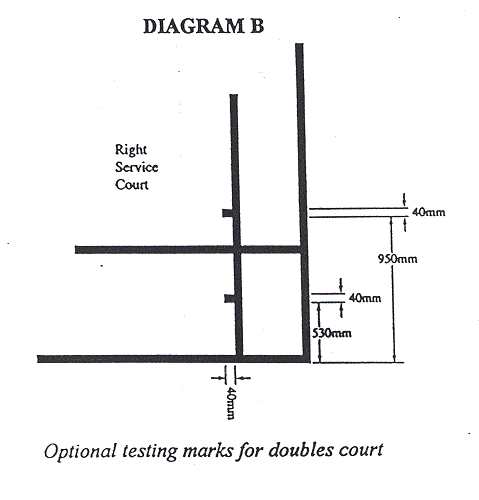
4. RACKET
4.1 The parts of a racket are described in Laws 4.1.1 to 4.1.7 and are
illustrated in Diagram C.
4.1.1 The main racket parts are called the handle, the stringed area, the
head, the shaft, the throat and the frame.
4.1.2 The handle is the part of the racket intended to be gripped by the
player.
4.1.3 The stringed area is the part of the racket with which it is intended
the player hits the shuttle.
4.1.4 The head bounds the stringed area.

4.1.5 The shaft connects the handle to the head (subject to Law 4.1.6).
4.1.6 The throat (if present) connects the shaft to the head.
4.1.7 The frame is the name given to the head, throat, shaft and handle
taken together.
4.2 The frame of the racket shall not exceed 680mm in overall length and
230mm in overall width.
4.3 Stringed area
4.3.1 The stringed area shall be flat and consist of a pattern of crossed
strings either alternately interlaced or bonded where they cross. The
stringing pattern shall be generally uniform and, in particular, not less
dense in the centre than in any other area.
4.3.2 The stringed area shall not exceed 280mm in overall length and 220mm
in overall width. However, the strings may extend into an area which otherwise
would be the throat, provided that the width of the extended stringed area
does not exceed 35mm and provided that the overall length of the stringed area
does not then exceed 330mm.
4.4 The racket:
4.4.1 shall be free of attached objects and protrusions, other than those
used solely and specifically to limit or prevent wear and tear, or vibration,
or to distribute weight, or to secure the handle by cord to the player's hand,
and which are reasonable in size and placement for such purposes; and
4.4.2 shall be free of any device which makes it possible for a player to
change materially the shape of the racket.
¡@
5. EQUIPMENT COMPLIANCE
The International Badminton Federation shall rule on any question of
whether any racket, shuttle or equipment or any prototype used in the playing
of badminton complies with the specifications. Such ruling may be undertaken
on the Federation's initiative or upon application by any party with a bona
fide interest therein, including any player, equipment manufacturer or Member
Association or member thereof.
¡@
6. TOSS
6.1 Before play commences, a toss shall be conducted and
the side winning the toss shall exercise the choice in either Law 6.1.1 or Law
6.1.2.
6.1.1 to serve or receive first.
6.1.2 To start play at one end of the court or the other.
6.2 The side losing the toss shall then exercise the
remaining choice.
¡@
7. SCORING SYSTEM
7.1 A match shall consist of the best of three games
unless, otherwise arranged.
7.2 In doubles and men's singles a game is won by the first
side to score 15 points, except as provided in Law 7.4.
7.3 In ladies' singles a game is won by the first side to score 11 points,
except as provided in Law 7.4.
7.4 If the score becomes 14-all (10-all in ladies'
singles), the side which first scored 14 (10) shall exercise the choice in Law
7.4.1 or 7.4.2;
7.4.1 to continue the game to 15 (11) points, ie not to 'set' the game;
or
7.4.2 to 'set' the game to 17 (13) points.
7.5 The side winning a game serves first in the next
game.
7.6 Only the serving end can add a point to its score (see
Law 10.3 or 11.4)
8. CHANGE OF ENDS
8.1 Players shall change ends:
8.1.1 at the end of the first game;
8.1.2 prior to the beginning of the third game (if any); and
8.1.3 in the third game, or in a match of one game , when the leading score
reaches:
- 6 in a game of 11 points; or
- 8 in a game of 15 points.
8.2 If players omit to change ends as indicated in Law 8.1,
they shall do so as soon as the mistake is discovered and the shuttle is not
in play. The existing score shall stand.
¡@
9. SERVICE
9.1 In a correct service:
9.1.1 neither side shall cause undue delay to the
delivery of the service once server and receiver have taken up their
respective positions;
9.1.2 the server and receiver shall stand within
diagonally opposite service courts without touching the boundary lines of
these service courts;
9.1.3 some part of both feet of the server and receiver
must remain in contact with the surface of the court in a stationary position
from the start of the service (Law 9.4) until the service is delivered (Law
9.6);
9.1.4 the server's racket shall initially hit the base of
the shuttle;
9.1.5 the whole shuttle shall be below the server's waist
at the instant of being hit by the server's racket;
9.1.6 the shaft of the server's racket at the instant of
hitting the shuttle shall be pointing in a downward direction to such an
extent that the whole of the head of the racket is discernibly below the whole
of the server's hand holding the racket as in Diagram D.
9.1.7 the movement of the server's racket must continue
forwards after the start of the service (Law 9.4) until the service is
delivered; and
9.1.8 the flight of the shuttle shall be upwards from the
server's racket to pass over the net so that, if not intercepted, it lands in
the receiver's service court (ie on or within the boundary lines).
9.2 If a service is not correct by virtue of any of Laws 9.1.1 to 9.1.8, it
shall be a 'fault' (Law 13) by the offending side.
9.3 It is a 'fault' if the server, in attempting to serve,
misses the shuttle.
9.4 Once the players have taken their positions, the first
forward movement of the server's racket head is the start of the service.
9.5 The server shall not serve before the receiver is ready
but the receiver shall be considered to have been ready if a return of service
is attempted.
9.6 Once the service is started (Law 9.4), it is delivered
when the shuttle is hit by the server's racket or, in attempting to serve, the
server misses the shuttle.
9.7 In doubles, the partners may take up any positions
which do not unsight the opposing server or receiver.

Positions of the racket and of the server's hand holding it at the
instant of striking the shuttle
10. SINGLES
10.1 Serving and receiving courts
10.1.1 The players shall serve from, and receive in, their respective right
service courts when the server has not scored or has scored an even number of
points in that game.
10.1.2 The players shall serve from, and receive in, their respective left
service courts when the server has scored an odd number of points in that
game.
10.2 The shuttle is hit alternately by the server and the
receiver until a 'fault' is made or the shuttle ceases to be in play.
10.3 Scoring and serving
10.3.1 If the receiver makes a 'fault' or the shuttle ceases to be in play
because it touches the surface of the court inside the receiver's court, the
server scores a point. The server then serves again from the alternate service
court.
10.3.2 If the server makes a 'fault' or the shuttle ceases to be in play
because it touches the surface of the court inside the server's court, the
server loses the right to continue serving and the receiver then becomes the
server, with no point scored by either player.
¡@
11. DOUBLES
11.1 At the start of a game, and each time a side gains
the right to serve, the service shall be delivered from the right service
court.
11.2 Only the receiver shall return the service: should
the shuttle touch or be hit by the receiver's partner, it shall be a 'fault'
and the serving side scores a point.
11.3 Order of play and position on court
11.3.1 After the service is returned, the shuttle may be
hit by either player of the serving side and then by either player of the
receiving side, and so on, until the shuttle ceases to be in play.
11.3.2 After the service is returned, a player may hit the shuttle from any
position on that player's side of the net.
11.4 Scoring and serving
11.4.1 If the receiving side makes a 'fault' or the shuttle ceases to be in
play because it touches the surface of the court inside the receiving side's
court, the serving side scores a point and the server serves again.
11.4.2 If the serving side makes a 'fault' or the shuttle ceases to be in
play because it touches the surface of the court inside the serving side's
court, the server loses the right to continue serving, with no point scored by
either side.
11.5 Serving and receiving courts
11.5.1 The player who serves at the start of any game shall serve from, or
receive in, the right service court when that player's side has not scored or
has scored an even number of points in that game and the left service court
when that player's side has scored an odd number of points in that game.
11.5.2 The player who receives at the start of any game shall receive in,
or serve from, the right service court when that player's side has not scored
or has scored an even number of points in that game and the left service court
when that player's side has scored an odd number of points in that game.
11.5.3 The reverse pattern shall apply to the partners.
11.6 Service in any turn of serving shall be delivered
from alternate service courts, except as provided in Laws 12 and 14.
11.7 In any game, the right to serve passes consecutively
from the initial server to the initial receiver, then to the initial
receiver's partner, then to the opponent who is due to serve from the right
service court (Law 11.5), then to that player's partner, and so on.
11.8 No player shall serve out of turn, receive out of
turn, or receive two consecutive services in the same game, except as provided
in Laws 12 and 14.
11.9 Either player of the winning side may serve first in
the next game, and either player of the losing side may receive.
¡@
12. SERVICE COURT ERRORS
12.1 A service court error has been made when a
player:
12.1.1 has served out of turn;
12.1.2 has served from the wrong service court; or
12.1.3 standing in the wrong service court, was prepared to receive the
service and it has been delivered.
12.2 If a service court error is discovered after the next
service has been delivered, the error shall not be corrected.
12.3 If a service court error is discovered before the next service is
delivered:
12.3.1 if both sides commiteed an error, it shall be a 'let'
12.3.2 if one side committed the error and won the rally, it shall be a
'let'
12.3.3 if one side committed the error and lost the rally, the error shall
not be corrected
12.4 If there is a 'let' because of a service court error, the rally is
replayed with the error corrected.
12.5 If a service court error is not to be corrected, play in that game
shall proceed without changing the players' new service courts (nor, when
relevant, the new order of serving).
¡@
13. FAULTS
It is a 'fault':
13.1 if a service is not correct (Law 9.1) or if Law 9.3
or 11.2 applies;
13.2 if in play, the shuttle:
13.2.1 lands outside the boundaries of the court
(ie not
on or within the boundary lines);
13.2.2 passes through or under the net;
13.2.3 fails to pass the net;
13.2.4 touches the ceiling or side walls;
13.2.5 touches the person or dress of a player; or
13.2.6 touches any other object or person outside the immediate
surroundings of the court;
(Where necessary on account of the structure of the building, the local
badminton authority may, subject to the right of veto of its Member
Association, make bye-laws dealing with cases in which a shuttle touches an
obstruction).
13.3 if, when in play, the initial point of contact with
the shuttle is not on the striker's side of the net. (The striker may,
however, follow the shuttle over the net with the racket in the course of a
stroke);
13.4 if, when the shuttle is in play, a player:
13.4.1 touches the net or its supports with racket,
person or dress;
13.4.2 invades an opponent's court over the net with
racket or person except as permitted in Law 13.3;
13.4.3 invades an opponent's court under the net with
racket or person such that an opponent is obstructed or distracted; or
13.4.4 obstructs an opponent, ie prevents an opponent
from making a legal stroke where the shuttle is followed over the net.
13.5 if, in play, a player deliberately distracts an
opponent by any action such as shouting or making gestures;
13.6 if, in play, the shuttle:
13.6.1 is caught and held on the racket and then slung
during the execution of a stroke;
13.6.2 is hit twice in succession by the same player
with two strokes;
13.6.3 is hit by a player and the player's partner
successively; or
13.6.4 touches a player's racket and continues towards the back of that
player's court;
13.7 if a player is guilty of flagrant, repeated or
persistent offences under Law 16.
13.8 if, on service, the shuttle is caught on the net and
remains suspended on top or, on service, after passing over the net is caught
in the net;
¡@
14. LETS
14.1 'Let' is called by the umpire, or by a player (if
there is no umpire) to halt play.
14.2 A 'let' may be given for any unforeseen or accidental
occurrence.
14.3 If a shuttle is caught on the net and remains
suspended on top or, after passing over the net, is caught in the net, it
shall be a 'let' except on service.
14.4 If, during service, the receiver and server are both
faulted at the same time, it shall be a 'let'.
14.5 If the server serves before the receiver is ready it
shall be a 'let'.
14.6 If during play, the shuttle disintegrates and the
base completely separates from the rest of the shuttle, it shall be a
'let'.
14.7 If a line judge is unsighted and the umpire is unable
to make a decision, it shall be a 'let'.
14.8 A 'let' may occur following a service court error;
see Law 12.3
14.9 When a 'let' occurs, the play since the last service
shall not count and the player who served shall serve again, except where Law
12 is applicable.
¡@
15. SHUTTLE NOT IN PLAY
A shuttle is not in play when:
15.1 it strikes the net and remains attached there or
suspended on top;
15.2 it strikes the net or post and starts to fall towards
the surface of the court on the striker's side of the net;
15.3 it hits the surface of the court; or
15.4 a 'fault' or 'let' has occurred.
¡@
16. CONTINUOUS PLAY, MISCONDUCT, PENALTIES
16.1 Play shall be continuous from the first service until
the match is concluded, except as allowed in Laws 16.2 and 16.3.
16.2 Intervals not exceeding 90 seconds between the first
and second games, and not exceeding 5 minutes between the second and third
games, are allowed in all matches in all of the following situations:
16.2.1 international competitive events;
16.2.2 IBF-sanctioned events; and
16.2.3 all other matches unless the Member Association has previously
published a decision not to allow such intervals.
(In televised matches the Referee may decide before the match that
intervals as in Law 16.2 are mandatory and of fixed duration.)
16.3 Suspension of play
16.3.1 When necessitated by circumstances not within the
control of the players, the umpire may suspend play for such a period as the
umpire may consider necessary
16.3.2 Under special cicumstances the Referee may instruct the umpire to
suspend play
16.3.3 If play is suspended, the existing score shall stand and play be
resumed from that point.
16.4 Under no circumstances shall play be delayed to
enable a player to recover strength or wind.
16.5 Advice and leaving the court
16.5.1 Except in the intervals provided in Laws 16.2 and
16.3, no player shall be permitted to receive advice during a match.
16.5.2 Except during the five-minute interval described
in Law 16.2, no player shall leave the court during a match without the
umpire's permission.
16.6 The umpire shall be the sole judge of any suspension
of play.
16.7 A player shall not:
16.7.1 deliberately cause delay in or suspension of
play;
16.7.2 deliberately modify or damage the shuttle in
order to change its speed or flight;
16.7.3 behave in an offensive manner; or
16.7.4 be guilty of misconduct not otherwise covered by
the Laws of badminton.
16.8 The umpire shall administer any breach of Law 16.4,
16.5 or 16.7 by:
16.8.1 issuing a warning to the offending side;
16.8.2 faulting the offending side, if previously warned; or
16.8.3 in cases of flagrant offence or persistent
offences, faulting the offending side and reporting the offending side
immediately to the Referee, who shall have power to disqualify the offending
side from the match.
¡@
17. OFFICIALS AND APPEALS
17.1 The Referee is in overall charge of the tournament or
event of which a match forms part.
17.2 The umpire, where appointed, is in charge of the
match, the court and its immediate surrounds. The umpire shall report to the
Referee.
17.3 The service judge shall call service faults made by
the server should they occur (Law 9).
17.4 A line judge shall indicate whether a shuttle landed
'in' or out' on the line(s) assigned.
17.5 An official's decision is final on all points of fact
for which that official is responsible.
17.6 An umpire shall:
17.6.1 uphold and enforce the Laws of badminton and,
especially, call a 'fault' or 'let' should either occur;
17.6.2 give a decision on any appeal regarding a point
of dispute, if made before the next service is delivered;
17.6.3 ensure players and spectators are kept informed of the progress of
the match;
17.6.4 appoint or remove line judges or a service judge in consultation
with the Referee;
17.6.5 where another court official is not appointed, arrange for that
official's duties to be carried out;
17.6.6 where an appointed official is unsighted, carry
out the official's duties or play a 'let';
17.6.7 record and report to the Referee all matters in
relation to Law 16; and
17.6.8 take to the Referee all unsatisfied appeals on
questions of law only. (Such appeals must be made before the next service is
delivered or, if at the end of the game, before the side that appeals has left
the court).
¡@
APPENDIX 1
VARIATIONS IN COURT AND EQUIPMENT
1. Where it is not practicable to have posts on the sidelines,
some method must be used to indicate the position of the sidelines where they
pass under the net, eg by the use of thin posts or strips of material 40 mm
wide, fixed to the side lines and rising vertically to the net cord.
2. Where space does not permit the marking out of a court for
doubles, a court may be marked out for singles only as shown in Diagram E. The
back boundary lines become also the long service lines and the posts or the
strips of material representing them shall be placed on the side
lines.
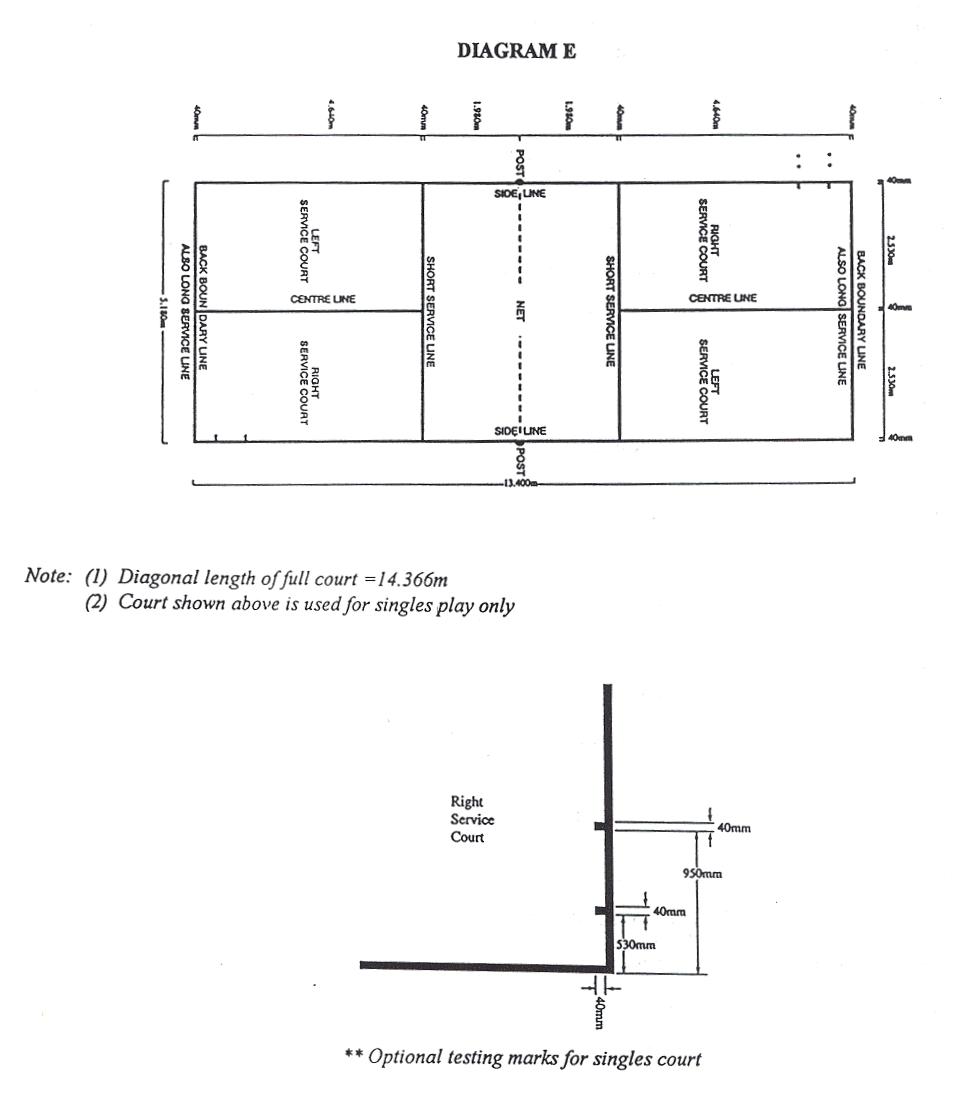
¡@
RECOMMENDATIONS TO COURT OFFICIALS
1. INTRODUCTION
1.1 The Recommendations to court officials are issued by the IBF in its
desire to standardise the control of the game in all countries and in
accordance with its Rules.
1.2 The purpose of these Recommendations is to advise umpires how to
control a match firmly and with fairness, without being officious, while
ensuring that the Laws of the game are observed. These Recommendations also
give guidance to service judges and line judges as to how to carry out their
duties.
1.3 All court officials should remember that the game is for the
players.
¡@
2. OFFICIALS AND THEIR DECISIONS
2.1 The umpire reports to and acts under the authority of the Referee (or
the responsible official in the absence of a Referee).
2.2 A service judge is normally appointed by the Referee, but can be
removed by the umpire in consultation with the Referee.
2.3 Line judges are normally appointed by the Referee, but a line judge can
be removed by the umpire in consultation with the Referee.
2.4 An official's decision is final on all points of fact for which that
official is responsible. (Law 17.5)
2.5 When another official is unsighted, the umpire makes the decision. When
no decision can be given, a 'let' is called.
2.6 The umpire is in charge of the court and its immediate surroundings.
The umpire's jurisdiction exists from entering the court before the match
until leaving the court after the match.
¡@
3. RECOMMENDATIONS TO UMPIRES
3.1 Before the match, the umpire shall:
3.1.1 obtain the scoresheet from the Referee;
3.1.2 ensure that any scoring device to be used is working;
3.1.3 see that the posts are on the lines or that the tapes are correctly
placed;
3.1.4 check the net for the height and ensure that there are no gaps
between the ends of the net and the net posts; (it is customary for the umpire
to delegate the duties in 3.1.3 and 3.1.4 to the service judge, where one is
appointed)
3.1.5 ascertain whether there are any bye-laws regarding the shuttle
hitting an obstruction;
3.1.6 ensure that the service judge and line judges know their duties and
that they are correctly placed (sections 5 and 6);
3.1.7 ensure that a sufficient quantity of tested shuttles (Law 3) are
readily available for the match in order to avoid delays during play; and
3.1.8 check that players' clothing conforms with the relevant Regulations
concerning advertising, and ensure that any violations are rectified. Any
decision that clothing was in violation of the Regulations (or was nearly so)
should be advised to the Referee or appropriate official before the match or,
if this is not possible, immediately after the match.
3.2 To start the match, the umpire shall:
3.2.1 ensure that the toss is fairly carried out and that the winning side
and the losing side exercise their choice correctly (Law 6);
3.2.2 note, in the case of doubles, the names of the players starting in
the right service court. Similar notes must be made at the start of each game
. (This enables a check to be made at any time to see if the players are in
the correct service court. If, during a game, a player commits a service court
error unnoticed so that the players have to stay wrong, change the note
accordingly); and
3.2.3 announce the match using the following announcement and pointing to
the right or left at the appropriate words in the announcement.
Tournament:
"Ladies and Gentlemen, on my right 'X' and on my left 'Y'. 'X' to serve;
love-all; play."
Team event:
"Ladies and Gentlemen, on my right 'A' (country name) represented by 'X'
and on my left 'B' represented by 'Y'. 'A' to serve; love-all; play."
In doubles, identify server and receiver by announcing:
Tournament: "..... on my right 'W' and 'X' and on my left 'Y' and
'Z'. 'X' to serve to 'Y'; love-all; play
Team event: "...... on my right 'A' represented by 'W' and 'X' and on my
left 'B' represented by 'Y' and 'Z'. 'A' to serve; 'X' to 'Y'; love-all;
play."
3.3 During the match the umpire shall record and call the
score.
3.3.1 Always call the server's score first.
3.3.2 In singles, when a player loses the right to continue serving,
call
"Service over"
followed by the score in favour of the new server.
3.3.3 In doubles, at the beginning of a game call the score only and
continue to do so as long as the first player serves. When the right to serve
is lost, call
"Service over"
followed by the score in favour of the new server. When the first server
loses the right to serve, call the score, followed by
"Second server"
Continue this as long as the second player serves. When a side loses the
right to serve, call
"Service over"
followed by the score in favour of the new server.
3.3.4 When a side reaches 14, or in the case of ladies' singles 10, call on
the first occasion only in each game
"Game point" or "Match point"
where applicable. If a further game or match point occurs after setting,
call it again on the first occasion. "Game point" (or "match point"), where
applicable, should always immediately follow the server's score and precede
the receiver's score.
When the score reaches 14-all (10-all), call on the first occasion only in
each game, and before asking if the side wishes to set
"14 game point all" or "14 match point all" ("10 game point all" or "10
match point all")
as appropriate.
3.3.5 "Play" should only be called by the umpire:
to indicate that a match or a game is about to start, or that a game after
changing ends, is to continue;
to indicate that play is to resume after a break; or
to indicate that the umpire is instructing players to resume play.
3.3.6 "Fault" should be called when a 'fault' occurs, except as
follows:
a 'fault' called by the service judge under Laws 9.1 to 9.3 which should be
recognised by calling 'Service fault called';
a fault occurring under Law 13.2.1, for which the line judge's call or
signal suffices;
and 'faults' occurring under Laws 13.2.2 or 13.2.3 which should only be
called if clarification is needed for players or spectators.
3.3.7 When appropriate, ask the relevant player
(side)
"Are you setting?"
and, if the answer is affirmative, call:
"Setting to 17 (13)"; (and "second server" - if appropriate)
or, if the answer is negative, call:
"Game not set; playing to 15 (11)".
When the game is set, call:
"Setting to 17 (13), 14 (10) - all" the first time and then
"14 (10) - all" (and "second server" - if appropriate) at all subsequent
calls, until the score changes.
3.3.8 At the end of every game, "game" must always be called immediately
the conclusive rally has ended, regardless of applause. Where appropriate this
constitutes the start of any interval allowed under Law 16.2.
After first game call:
"First game won by ......[name(s) of player(s), or team (in a team event)]
...[score]".
After second game call:
"Second game won by ...... [name(s) of player(s), or team (in a team event)
...[score]".
If a game wins the match, call instead:
"Match won by ...... [name(s) of player(s), or team (in a team event)]
......[scores]".
3.3.9 In the interval between first and second game, after 70 seconds
have elapsed call:
"[Court ...] 20 seconds". Repeat the call.
In the interval between the first and second game each side may be joined
on court by no more than two persons. These persons shall join the side after
ends have been changed, and shall leave the court when the umpire calls "...
20 seconds".
To start the second game, call:
"Second game, love all, play".
3.3.10 If there is to be a third game, call:
"One game all" immediately after the call in Recommendation 3.3.8.
If a five minute interval is being claimed, call:
"[Court ... ] , a five minute interval".
After three minutes have elapsed, call:
"[Court ... ] , two minutes." Repeat the call.
After four minutes have elapsed, call:
"[Court ... ] , one minute." Repeat the call.
To start the third game, call:
"Final game; love all; play".
3.3.11 In the third game, or in a match of one game, call the score
followed by "Change ends" when the leading score reaches 6 or 8, as
appropriate (Law 8.1.3).
Once the players have changed ends the score should be repeated, followed
by "play".
3.3.12 At the end of the match immediately take the completed
scoresheet to the Referee.
3.4 If a service judge is appointed, the umpire shall especially watch the
receiver.
3.5 The umpire should always look to the line judge(s) when the shuttle
lands close to a line and always when the shuttle lands out, however far. The
line judge is entirely responsible for the decision.
3.6 During the match the umpire shall:
3.6.1 if possible, keep aware of the status of any scoring device; and
3.6.2 when the shuttle lands outside a line for which the umpire is
responsible in the absence of a line judge, or if the line judge is unsighted,
call:
"Out"
before calling the score.
3.7 During the match the umpire shall use the standard
vocabulary in Appendix 4 of the Laws of Badminton.
3.8 During the match the following situations should be watched for and
dealt with as detailed:
3.8.1 A player sliding under the net (and who also thereby obstructs or
distracts an opponent), or throwing a racket into the opponent's court should
be faulted under Law 13.4.3 or 13.4.23 respectively.
3.8.2 A player shouting to a partner who is about to hit
the shuttle should not necessarily be regarded as distracting the opponents.
Calling 'no shot', 'fault', etc should be considered a distraction.
3.8.3 Coaching during a match from off court should be
prevented. If this cannot be controlled by the umpire, the Referee should be
informed immediately.
3.8.4 Players going off court to wipe their hands etc;
if play is not held up, this is acceptable, but, if one side is ready to play,
the offending side may have to be reminded that leaving the court needs the
umpire's permission (Law 16.5.2). If necessary, Law 16.8 should be
applied.
3.8.5 Changing the shuttle during the match should not
be unfair. If both sides agree to the change, there should be no objection by
the umpire. If only one side wishes to change the shuttle, the umpire should
take the decision, having the shuttle tested if necessary.
3.8.6 Law 13.6; a double hit by one player with one
stroke is not a 'fault'.
3.9 Ensure that players do not leave the court without the umpire's
permission. However, a change of a racket at courtside during a rally is
permitted.
3.10 Injury or sickness during a match must be handled
carefully and flexibly. The umpire must determine the severity of the problem
as quickly as possible. Normally, the only people that should be allowed on
court are a doctor or paramedic and the Referee.
The opposing side must not be put at a disadvantage and Laws 16.4, 16.5,
16.7.1, and 16.8 should be applied appropriately.
When appropriate, because of injury, illness or other unavoidable
hindrance, ask the player;
"Are you retiring?"
and if the answer is affirmative, call
"Match won by...[name of player/team] ... [scores]"
3.11 If play has to be suspended, call:
"Play is suspended"
and record the score, server, receiver, correct service court and ends.
When play resumes call:
"Are you ready?"
call the score (and, if appropriate, "first server") and
"Play".
3.12 A shuttle whose speed or flight has been
interfered with should be discarded.
3.13 Misconduct.
 3.13.1
3.13.1
Record and report to the Referee any incidents of misconduct and the action
taken.
3.13.2
Misconduct between games is treated as misconduct during a game. The umpire
announces the decision at the start of the following game.
3.13.3
If Law 16.8 is to be applied, call
"Come here"
to the offending player and call
"...... [name of player], warning for misconduct"
or
"...... [name of player], fault for misconduct"
at the same time raising the right hand above your head.
3.14 If you want assistance from the Referee raise your right hand above
your head.
¡@
4. GENERAL ADVICE ON UMPIRING
This section gives general advice which should be followed.
4.1 Know and understand the Laws of badminton.
4.2 Call promptly and with authority, but, if a mistake is
made, admit it, apologise and correct it.
4.3 All announcements and calling of the score must be done distinctly and
loudly enough to be heard clearly by players and spectators.
4.4 When a doubt arises in your mind as to whether an infringement of the
Laws has occurred or not, "fault" should not be called and the game allowed to
proceed.
4.5 Never ask spectators nor be influenced by them or their remarks.
4.6 Motivate your other court officials, eg by discreetly acknowledging the
decisions of line judges and establishing a working relationship with
them.
¡@
5. INSTRUCTIONS TO SERVICE JUDGES
5.1 The service judge shall sit on a low chair by the post, preferably
opposite the umpire.
5.2 The service judge is responsible for judging that the
server delivers a correct service. If not, call 'fault' loudly and use the
approved hand signal to indicate the type of infringement.
5.3 The approved hand signals are: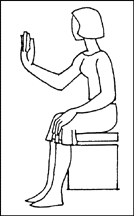
Law 9.1.6
At the instant of hitting the shuttle,
the shaft of the racket not
pointing in a downward direction
to such an extent that the whole
of the head of the racket is
discernibly below the whole of
the
server's hand holding the racket.

Law 9.1.5
Whole of the shuttle
not below the server's
waist at the moment
of being struck.
¡@
¡@
¡@
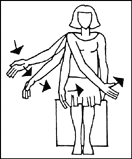
Laws 9.4 and 9.1.7
Once the players have
taken their positions, the first
forward
movement of the server's
racket head is the start of the service.
The
movement of the racket must
continue forwards.
¡@
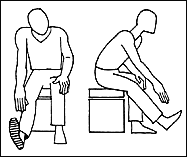
Law 9.1.2 and 9.1.3
Some part of both feet
not in the service court
and in a stationary
position until the service
is delivered.
¡@
¡@

Law 9.1.4
Initial point of
contact with
the shuttle not
on the base of
the shuttle.
¡@
¡@
¡@
5.4 The umpire may arrange with the service judge any
extra duties to be undertaken, provided that the players are so advised.
¡@
6. INSTRUCTIONS TO LINE JUDGES
6.1 Line judges should be sited on chairs in prolongation of their lines at
the ends and sides of the court and preferably at the side opposite to the
umpire. (See diagrams).
6.2 A line judge is entirely responsible for the line(s) assigned. If the
shuttle lands out, no matter how far, call "out" promptly in a clear voice,
loud enough to be heard by the players and the spectators and, at the same
time, signal by extending both arms horizontally so that the umpire can see
clearly.
If the shuttle falls in, the line judge shall say nothing, but point to the
line with the right hand.
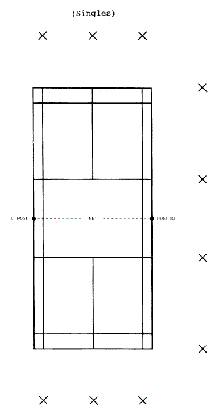 X Position of line judges
X Position of line judges
Where practical, it is recommended that the line judges' position be 2.5 to
3.5 metres from the court boundaries and, in any arrangement, the line judges'
positions be protected from encroachment by any outside influence, eg by
photographers.
 X Position of line judges
X Position of line judges
Where practical, it is recommended that the line judges' position be 2.5 to
3.5 metres from the court boundaries and, in any arrangement, the line judges'
positions be protected from encroachment by any outside influence, eg by
photographers.
6.3 If unsighted, inform the umpire immediately by putting both hands up to
cover the eyes.
6.4 Do not call or signal until the shuttle has touched the floor.
6.5 Calls should always be made, and no anticipation made of umpiring
decisions, eg that the shuttle hit a player.

SHUTTLE IS OUT
If the shuttle lands out, no matter
how far, call "out" promptly
in
a clear voice, loud enough to
be heard by the players and the|
spectators and, at the same time,
signal by extending both arms
horizontally so that the umpire
can see clearly.
¡@
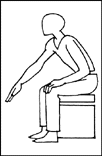
SHUTTLE IS IN
If the shuttle lands in,
say nothing, but point
to the line with
your
right hand.
¡@
¡@
¡@

IF UNSIGHTED
If unsighted, inform
the umpire immediately
by holding your hands
to cover your eyes.
¡@
Top
Back
¡@